MCR001 Economic Environment Report: Trade Restrictions and Australia
VerifiedAdded on 2022/10/11
|7
|1499
|22
Report
AI Summary
This report analyzes the economic environment, specifically focusing on the trade war between the United States and China. It examines the reasons behind the trade war, including trade imbalances and intellectual property theft, and evaluates the economic justifications provided by the Trump administration for imposing tariffs. The report discusses the responses of both countries, the impact on the global economy, with a specific focus on the Australian economy, and the current state of the trade war. It uses economic concepts to assess the effects of tariffs, trade restrictions, and the resulting economic consequences, such as changes in trade surplus, consumer prices, and investment sentiments. The report concludes with an overview of the losses and gains of the trade war, emphasizing the impact on the US and Chinese economies, and the world economy as a whole.
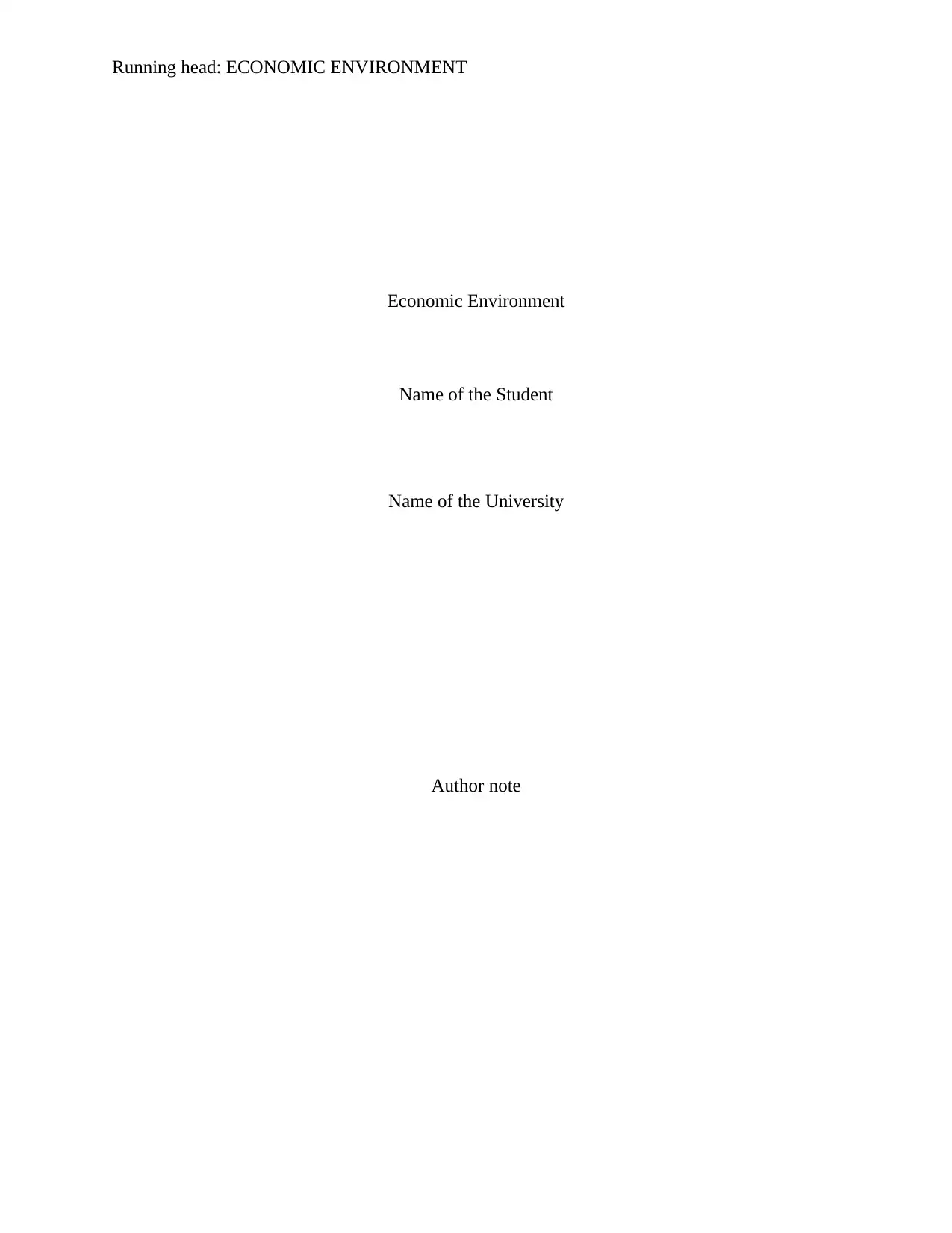
Running head: ECONOMIC ENVIRONMENT
Economic Environment
Name of the Student
Name of the University
Author note
Economic Environment
Name of the Student
Name of the University
Author note
Paraphrase This Document
Need a fresh take? Get an instant paraphrase of this document with our AI Paraphraser
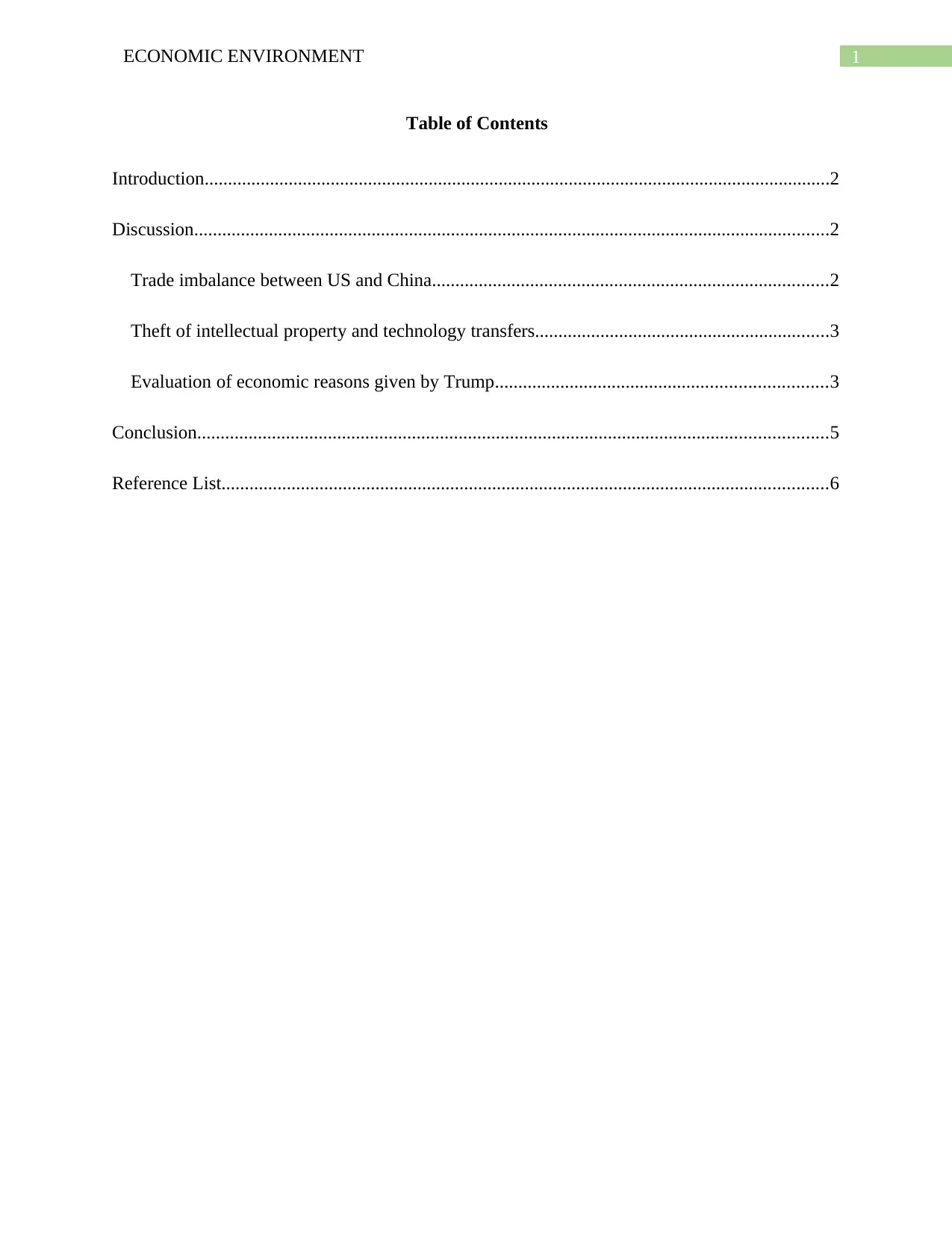
1ECONOMIC ENVIRONMENT
Table of Contents
Introduction......................................................................................................................................2
Discussion........................................................................................................................................2
Trade imbalance between US and China.....................................................................................2
Theft of intellectual property and technology transfers...............................................................3
Evaluation of economic reasons given by Trump.......................................................................3
Conclusion.......................................................................................................................................5
Reference List..................................................................................................................................6
Table of Contents
Introduction......................................................................................................................................2
Discussion........................................................................................................................................2
Trade imbalance between US and China.....................................................................................2
Theft of intellectual property and technology transfers...............................................................3
Evaluation of economic reasons given by Trump.......................................................................3
Conclusion.......................................................................................................................................5
Reference List..................................................................................................................................6
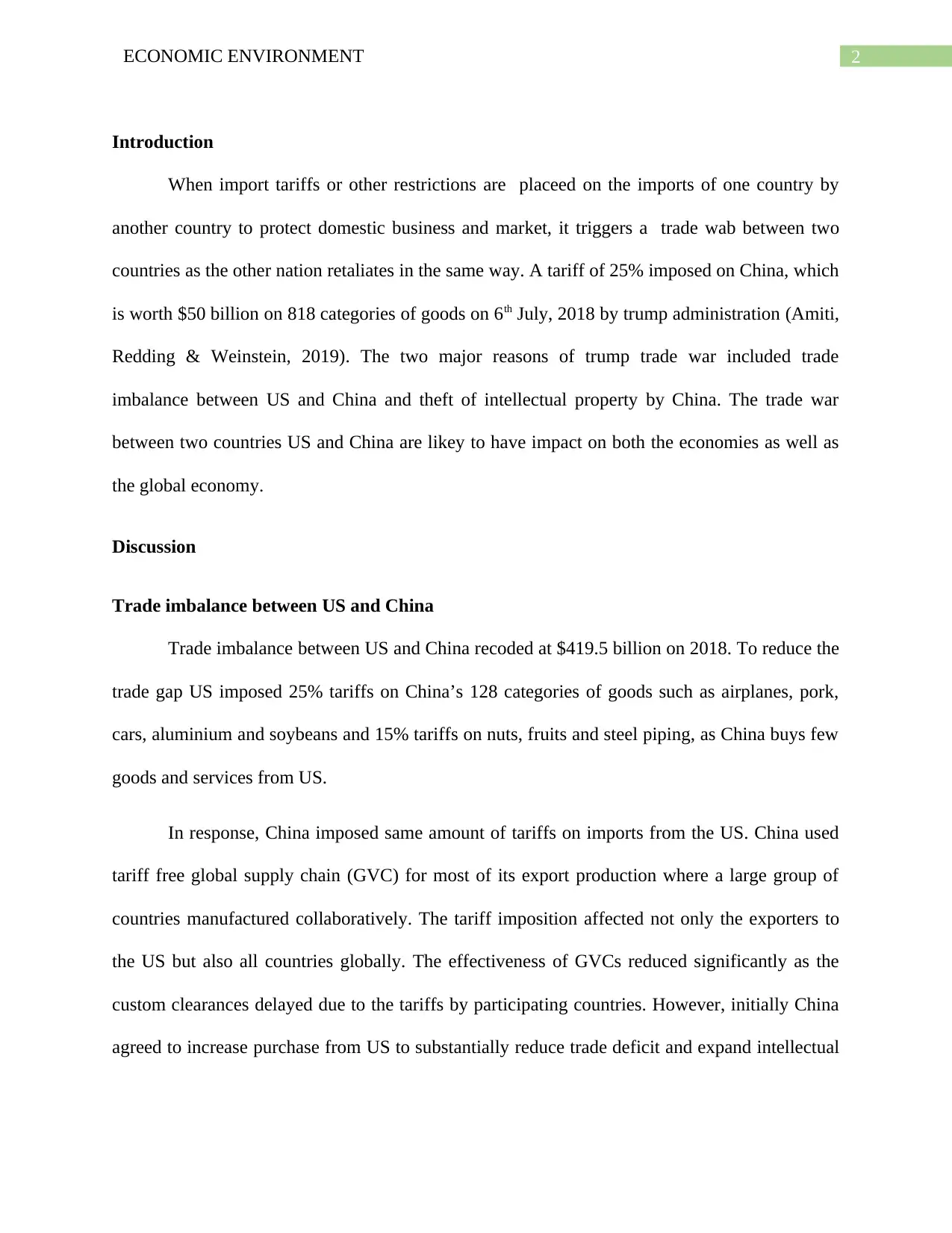
2ECONOMIC ENVIRONMENT
Introduction
When import tariffs or other restrictions are placeed on the imports of one country by
another country to protect domestic business and market, it triggers a trade wab between two
countries as the other nation retaliates in the same way. A tariff of 25% imposed on China, which
is worth $50 billion on 818 categories of goods on 6th July, 2018 by trump administration (Amiti,
Redding & Weinstein, 2019). The two major reasons of trump trade war included trade
imbalance between US and China and theft of intellectual property by China. The trade war
between two countries US and China are likey to have impact on both the economies as well as
the global economy.
Discussion
Trade imbalance between US and China
Trade imbalance between US and China recoded at $419.5 billion on 2018. To reduce the
trade gap US imposed 25% tariffs on China’s 128 categories of goods such as airplanes, pork,
cars, aluminium and soybeans and 15% tariffs on nuts, fruits and steel piping, as China buys few
goods and services from US.
In response, China imposed same amount of tariffs on imports from the US. China used
tariff free global supply chain (GVC) for most of its export production where a large group of
countries manufactured collaboratively. The tariff imposition affected not only the exporters to
the US but also all countries globally. The effectiveness of GVCs reduced significantly as the
custom clearances delayed due to the tariffs by participating countries. However, initially China
agreed to increase purchase from US to substantially reduce trade deficit and expand intellectual
Introduction
When import tariffs or other restrictions are placeed on the imports of one country by
another country to protect domestic business and market, it triggers a trade wab between two
countries as the other nation retaliates in the same way. A tariff of 25% imposed on China, which
is worth $50 billion on 818 categories of goods on 6th July, 2018 by trump administration (Amiti,
Redding & Weinstein, 2019). The two major reasons of trump trade war included trade
imbalance between US and China and theft of intellectual property by China. The trade war
between two countries US and China are likey to have impact on both the economies as well as
the global economy.
Discussion
Trade imbalance between US and China
Trade imbalance between US and China recoded at $419.5 billion on 2018. To reduce the
trade gap US imposed 25% tariffs on China’s 128 categories of goods such as airplanes, pork,
cars, aluminium and soybeans and 15% tariffs on nuts, fruits and steel piping, as China buys few
goods and services from US.
In response, China imposed same amount of tariffs on imports from the US. China used
tariff free global supply chain (GVC) for most of its export production where a large group of
countries manufactured collaboratively. The tariff imposition affected not only the exporters to
the US but also all countries globally. The effectiveness of GVCs reduced significantly as the
custom clearances delayed due to the tariffs by participating countries. However, initially China
agreed to increase purchase from US to substantially reduce trade deficit and expand intellectual
⊘ This is a preview!⊘
Do you want full access?
Subscribe today to unlock all pages.

Trusted by 1+ million students worldwide
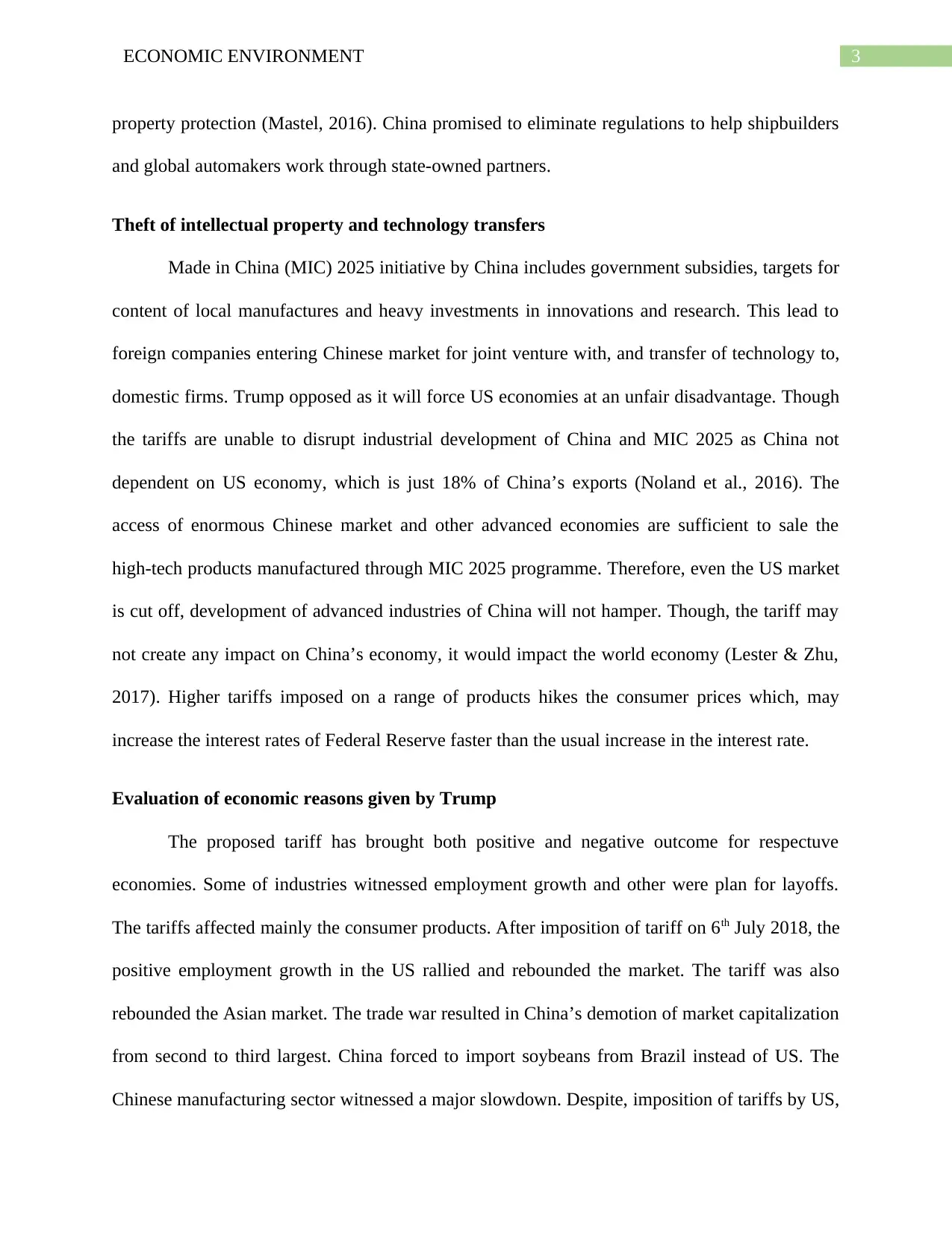
3ECONOMIC ENVIRONMENT
property protection (Mastel, 2016). China promised to eliminate regulations to help shipbuilders
and global automakers work through state-owned partners.
Theft of intellectual property and technology transfers
Made in China (MIC) 2025 initiative by China includes government subsidies, targets for
content of local manufactures and heavy investments in innovations and research. This lead to
foreign companies entering Chinese market for joint venture with, and transfer of technology to,
domestic firms. Trump opposed as it will force US economies at an unfair disadvantage. Though
the tariffs are unable to disrupt industrial development of China and MIC 2025 as China not
dependent on US economy, which is just 18% of China’s exports (Noland et al., 2016). The
access of enormous Chinese market and other advanced economies are sufficient to sale the
high-tech products manufactured through MIC 2025 programme. Therefore, even the US market
is cut off, development of advanced industries of China will not hamper. Though, the tariff may
not create any impact on China’s economy, it would impact the world economy (Lester & Zhu,
2017). Higher tariffs imposed on a range of products hikes the consumer prices which, may
increase the interest rates of Federal Reserve faster than the usual increase in the interest rate.
Evaluation of economic reasons given by Trump
The proposed tariff has brought both positive and negative outcome for respectuve
economies. Some of industries witnessed employment growth and other were plan for layoffs.
The tariffs affected mainly the consumer products. After imposition of tariff on 6th July 2018, the
positive employment growth in the US rallied and rebounded the market. The tariff was also
rebounded the Asian market. The trade war resulted in China’s demotion of market capitalization
from second to third largest. China forced to import soybeans from Brazil instead of US. The
Chinese manufacturing sector witnessed a major slowdown. Despite, imposition of tariffs by US,
property protection (Mastel, 2016). China promised to eliminate regulations to help shipbuilders
and global automakers work through state-owned partners.
Theft of intellectual property and technology transfers
Made in China (MIC) 2025 initiative by China includes government subsidies, targets for
content of local manufactures and heavy investments in innovations and research. This lead to
foreign companies entering Chinese market for joint venture with, and transfer of technology to,
domestic firms. Trump opposed as it will force US economies at an unfair disadvantage. Though
the tariffs are unable to disrupt industrial development of China and MIC 2025 as China not
dependent on US economy, which is just 18% of China’s exports (Noland et al., 2016). The
access of enormous Chinese market and other advanced economies are sufficient to sale the
high-tech products manufactured through MIC 2025 programme. Therefore, even the US market
is cut off, development of advanced industries of China will not hamper. Though, the tariff may
not create any impact on China’s economy, it would impact the world economy (Lester & Zhu,
2017). Higher tariffs imposed on a range of products hikes the consumer prices which, may
increase the interest rates of Federal Reserve faster than the usual increase in the interest rate.
Evaluation of economic reasons given by Trump
The proposed tariff has brought both positive and negative outcome for respectuve
economies. Some of industries witnessed employment growth and other were plan for layoffs.
The tariffs affected mainly the consumer products. After imposition of tariff on 6th July 2018, the
positive employment growth in the US rallied and rebounded the market. The tariff was also
rebounded the Asian market. The trade war resulted in China’s demotion of market capitalization
from second to third largest. China forced to import soybeans from Brazil instead of US. The
Chinese manufacturing sector witnessed a major slowdown. Despite, imposition of tariffs by US,
Paraphrase This Document
Need a fresh take? Get an instant paraphrase of this document with our AI Paraphraser
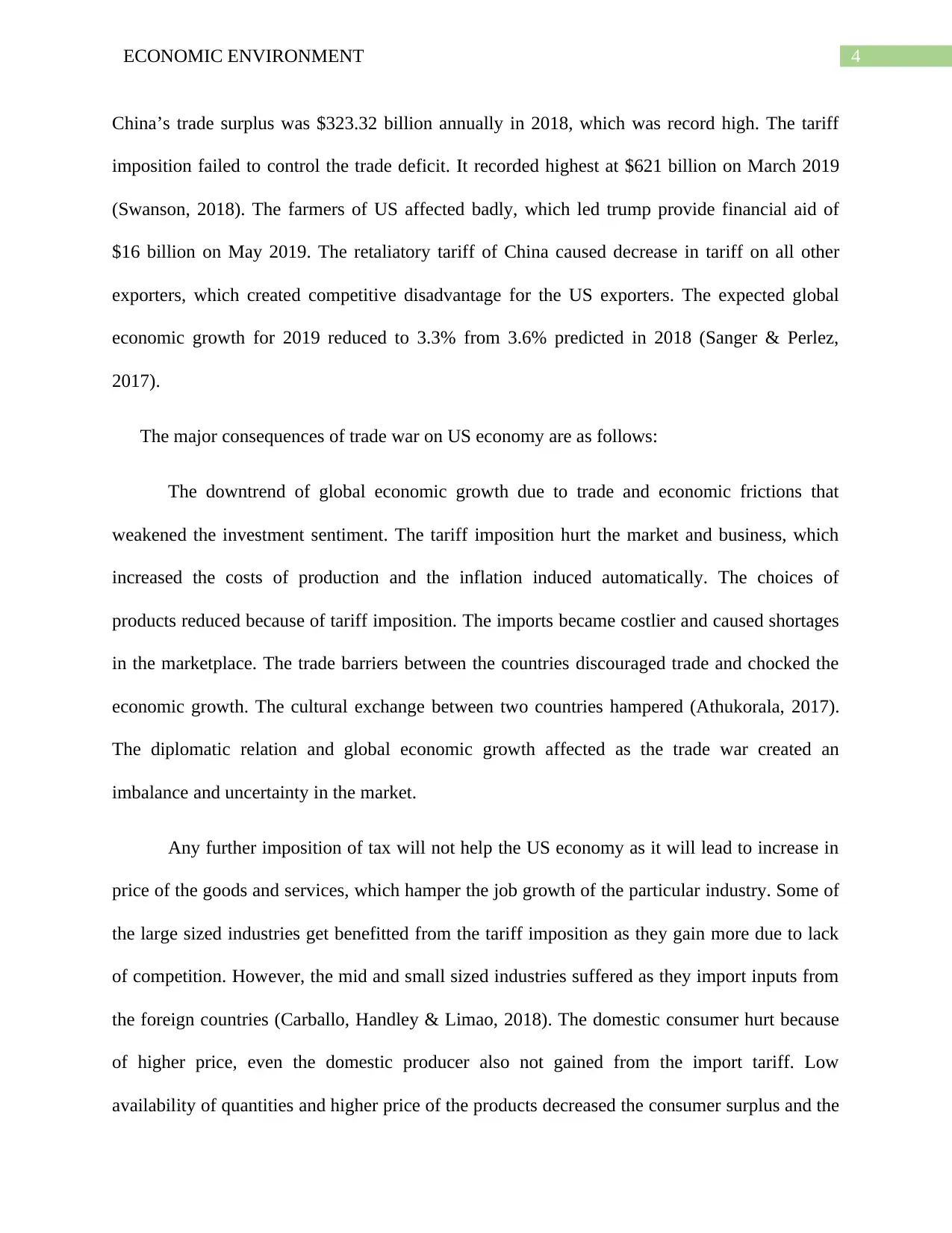
4ECONOMIC ENVIRONMENT
China’s trade surplus was $323.32 billion annually in 2018, which was record high. The tariff
imposition failed to control the trade deficit. It recorded highest at $621 billion on March 2019
(Swanson, 2018). The farmers of US affected badly, which led trump provide financial aid of
$16 billion on May 2019. The retaliatory tariff of China caused decrease in tariff on all other
exporters, which created competitive disadvantage for the US exporters. The expected global
economic growth for 2019 reduced to 3.3% from 3.6% predicted in 2018 (Sanger & Perlez,
2017).
The major consequences of trade war on US economy are as follows:
The downtrend of global economic growth due to trade and economic frictions that
weakened the investment sentiment. The tariff imposition hurt the market and business, which
increased the costs of production and the inflation induced automatically. The choices of
products reduced because of tariff imposition. The imports became costlier and caused shortages
in the marketplace. The trade barriers between the countries discouraged trade and chocked the
economic growth. The cultural exchange between two countries hampered (Athukorala, 2017).
The diplomatic relation and global economic growth affected as the trade war created an
imbalance and uncertainty in the market.
Any further imposition of tax will not help the US economy as it will lead to increase in
price of the goods and services, which hamper the job growth of the particular industry. Some of
the large sized industries get benefitted from the tariff imposition as they gain more due to lack
of competition. However, the mid and small sized industries suffered as they import inputs from
the foreign countries (Carballo, Handley & Limao, 2018). The domestic consumer hurt because
of higher price, even the domestic producer also not gained from the import tariff. Low
availability of quantities and higher price of the products decreased the consumer surplus and the
China’s trade surplus was $323.32 billion annually in 2018, which was record high. The tariff
imposition failed to control the trade deficit. It recorded highest at $621 billion on March 2019
(Swanson, 2018). The farmers of US affected badly, which led trump provide financial aid of
$16 billion on May 2019. The retaliatory tariff of China caused decrease in tariff on all other
exporters, which created competitive disadvantage for the US exporters. The expected global
economic growth for 2019 reduced to 3.3% from 3.6% predicted in 2018 (Sanger & Perlez,
2017).
The major consequences of trade war on US economy are as follows:
The downtrend of global economic growth due to trade and economic frictions that
weakened the investment sentiment. The tariff imposition hurt the market and business, which
increased the costs of production and the inflation induced automatically. The choices of
products reduced because of tariff imposition. The imports became costlier and caused shortages
in the marketplace. The trade barriers between the countries discouraged trade and chocked the
economic growth. The cultural exchange between two countries hampered (Athukorala, 2017).
The diplomatic relation and global economic growth affected as the trade war created an
imbalance and uncertainty in the market.
Any further imposition of tax will not help the US economy as it will lead to increase in
price of the goods and services, which hamper the job growth of the particular industry. Some of
the large sized industries get benefitted from the tariff imposition as they gain more due to lack
of competition. However, the mid and small sized industries suffered as they import inputs from
the foreign countries (Carballo, Handley & Limao, 2018). The domestic consumer hurt because
of higher price, even the domestic producer also not gained from the import tariff. Low
availability of quantities and higher price of the products decreased the consumer surplus and the
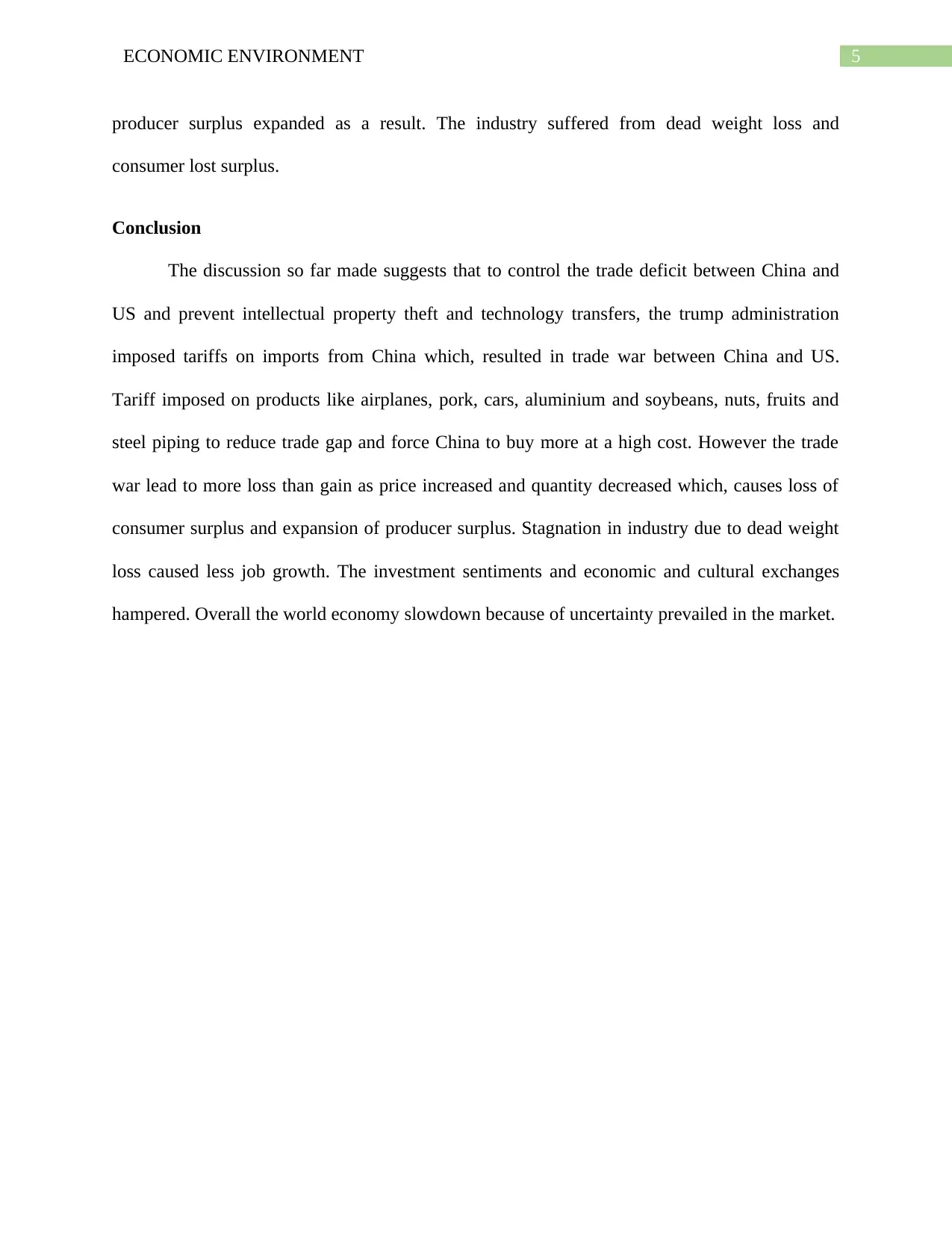
5ECONOMIC ENVIRONMENT
producer surplus expanded as a result. The industry suffered from dead weight loss and
consumer lost surplus.
Conclusion
The discussion so far made suggests that to control the trade deficit between China and
US and prevent intellectual property theft and technology transfers, the trump administration
imposed tariffs on imports from China which, resulted in trade war between China and US.
Tariff imposed on products like airplanes, pork, cars, aluminium and soybeans, nuts, fruits and
steel piping to reduce trade gap and force China to buy more at a high cost. However the trade
war lead to more loss than gain as price increased and quantity decreased which, causes loss of
consumer surplus and expansion of producer surplus. Stagnation in industry due to dead weight
loss caused less job growth. The investment sentiments and economic and cultural exchanges
hampered. Overall the world economy slowdown because of uncertainty prevailed in the market.
producer surplus expanded as a result. The industry suffered from dead weight loss and
consumer lost surplus.
Conclusion
The discussion so far made suggests that to control the trade deficit between China and
US and prevent intellectual property theft and technology transfers, the trump administration
imposed tariffs on imports from China which, resulted in trade war between China and US.
Tariff imposed on products like airplanes, pork, cars, aluminium and soybeans, nuts, fruits and
steel piping to reduce trade gap and force China to buy more at a high cost. However the trade
war lead to more loss than gain as price increased and quantity decreased which, causes loss of
consumer surplus and expansion of producer surplus. Stagnation in industry due to dead weight
loss caused less job growth. The investment sentiments and economic and cultural exchanges
hampered. Overall the world economy slowdown because of uncertainty prevailed in the market.
⊘ This is a preview!⊘
Do you want full access?
Subscribe today to unlock all pages.

Trusted by 1+ million students worldwide
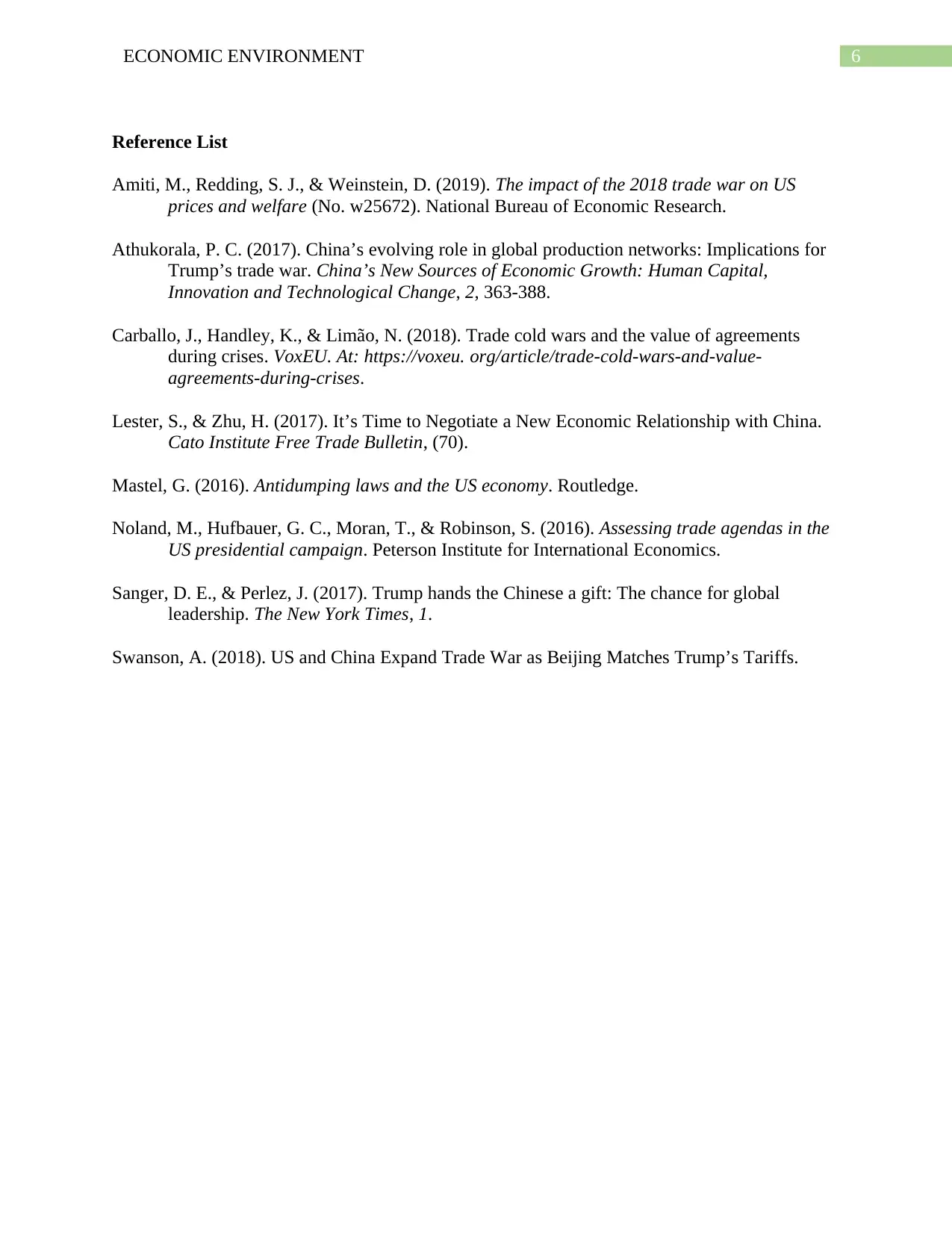
6ECONOMIC ENVIRONMENT
Reference List
Amiti, M., Redding, S. J., & Weinstein, D. (2019). The impact of the 2018 trade war on US
prices and welfare (No. w25672). National Bureau of Economic Research.
Athukorala, P. C. (2017). China’s evolving role in global production networks: Implications for
Trump’s trade war. China’s New Sources of Economic Growth: Human Capital,
Innovation and Technological Change, 2, 363-388.
Carballo, J., Handley, K., & Limão, N. (2018). Trade cold wars and the value of agreements
during crises. VoxEU. At: https://voxeu. org/article/trade-cold-wars-and-value-
agreements-during-crises.
Lester, S., & Zhu, H. (2017). It’s Time to Negotiate a New Economic Relationship with China.
Cato Institute Free Trade Bulletin, (70).
Mastel, G. (2016). Antidumping laws and the US economy. Routledge.
Noland, M., Hufbauer, G. C., Moran, T., & Robinson, S. (2016). Assessing trade agendas in the
US presidential campaign. Peterson Institute for International Economics.
Sanger, D. E., & Perlez, J. (2017). Trump hands the Chinese a gift: The chance for global
leadership. The New York Times, 1.
Swanson, A. (2018). US and China Expand Trade War as Beijing Matches Trumpʼs Tariffs.
Reference List
Amiti, M., Redding, S. J., & Weinstein, D. (2019). The impact of the 2018 trade war on US
prices and welfare (No. w25672). National Bureau of Economic Research.
Athukorala, P. C. (2017). China’s evolving role in global production networks: Implications for
Trump’s trade war. China’s New Sources of Economic Growth: Human Capital,
Innovation and Technological Change, 2, 363-388.
Carballo, J., Handley, K., & Limão, N. (2018). Trade cold wars and the value of agreements
during crises. VoxEU. At: https://voxeu. org/article/trade-cold-wars-and-value-
agreements-during-crises.
Lester, S., & Zhu, H. (2017). It’s Time to Negotiate a New Economic Relationship with China.
Cato Institute Free Trade Bulletin, (70).
Mastel, G. (2016). Antidumping laws and the US economy. Routledge.
Noland, M., Hufbauer, G. C., Moran, T., & Robinson, S. (2016). Assessing trade agendas in the
US presidential campaign. Peterson Institute for International Economics.
Sanger, D. E., & Perlez, J. (2017). Trump hands the Chinese a gift: The chance for global
leadership. The New York Times, 1.
Swanson, A. (2018). US and China Expand Trade War as Beijing Matches Trumpʼs Tariffs.
1 out of 7
Related Documents
Your All-in-One AI-Powered Toolkit for Academic Success.
+13062052269
info@desklib.com
Available 24*7 on WhatsApp / Email
![[object Object]](/_next/static/media/star-bottom.7253800d.svg)
Unlock your academic potential
Copyright © 2020–2025 A2Z Services. All Rights Reserved. Developed and managed by ZUCOL.





